
by Contributed | Sep 15, 2021 | Dynamics 365, Microsoft 365, Technology
This article is contributed. See the original author and article here.
It’s time for us to bring all new and future HR capabilities and enhancements within Dynamics 365 Human Resources to all our customers.
We currently have two separate sets of human resources capabilities on two different infrastructures within Dynamics 365:
- Dynamics 365 Human Resources, which is a complete stand-alone application running on an independent infrastructure. Our customers use this application to increase organizational agility and get workforce insights. All investments over the last three years have been focused on this application.
- The HR module, which is a legacy set of capabilities that was previously part of our Unified Operations licensing bundle. Our customers received these HR capabilities as part of Dynamics 365 Finance or Dynamics 365 Supply Chain Management. We have not been adding capabilities or enhancements to this module. The HR module runs on the same infrastructure as the other applications within our operations portfolio, which was previously named Finance and Operations.
As you can imagine, having two ways to access HR capabilities creates a lot of confusion. It also prevents our customers from experiencing the benefits that each set of capabilities offers.
By merging these capabilities onto the same infrastructure, our customers will see:
- All the enhancements that we have added over the last three years, including improved leave and absence, benefit management, and reporting.
- Improved extensibility through the Microsoft Power Platform and the ability to extend business logic to personalize screens and forms.
- Improved deployment, updates, and maintenance with consistency in terms of Application Life Cycle Management, Lifecycle Services, Geographic availability, and more.
- More technology innovation within the roadmap, as our engineering team now can utilize shared services, tooling, and reduce platform costs.
Dynamics 365 Human Resources will continue to be licensed and sold as a stand-alone application. With the merge, it will tap into the power of the Dynamics 365 shared infrastructure, the Power Platform, and the Dataverse.
This transition will impact customers that are currently running Dynamics 365 Human Resources and those that are using the HR module.
Here are some frequently asked questions and answers to help with the transition.
When will the Dynamics 365 Human Resources infrastructure merge be completed?
The infrastructure merge will roll out in phases to better support all customers and provide time for transition planning. You will see new capabilities begin to roll out in the 2021 Wave 2 release. For more details, see the Dynamics 365 Human Resources 2021 release wave 2 plan. These phases will align with the version service updates, which start with the One Version service updates that start as a preview in December 2021. The merge will be complete in the 2022 Wave 1 release. (These dates are subject to change, so refer to the release plans for the most up-to-date information.)
When should my organization transition into the new infrastructure?
The transition for each company will depend on your current configuration and readiness to move to the new infrastructure. We recommend working with your business partner to determine the best path forward for your company.
- Organizations that use the HR module will receive new functionality as part of the regular One Version update process. Features are planned to become generally available beginning in January 2022 (dates are subject to change, so refer to the release plans for the most up-to-date information).
- Organizations using Dynamics 365 Human Resources will have access to migration tools to complete the infrastructure merge. Please check the release plans regularly to get up-to-date information on when these tools will be available. We will work with our customers to make the transition without an interruption in service. Customers will need to make the transition 12-18 months from when the migration tooling is available.
- Organizations that use both Dynamics 365 Human Resources and the HR module will also need to use the migration tooling.
Will I lose any features or capabilities that I currently use?
Our objective is to minimize the impact of this transition for our customers, and we will not be removing any features. There will be functional parity between Dynamics 365 Human Resources and the HR module. In cases where the feature exists in both infrastructures, the Dynamics 365 Human Resources experience will be used.
Will the experience change for my users?
New capabilities will be managed through Feature management. This will allow our customers to decide which features they want to utilize. In some cases, we may need to change the experience; however, in those cases, documentation will be provided.
Are there any licensing changes or minimum number of user requirements?
Customers that have purchased Dynamics 365 Human Resources will not require license changes. The additional sandbox stock-keeping unit (SKU) that was specific for Human Resources will no longer be applicable. Instead, customers can choose to buy a Finance and Operations apps Tier 2 sandbox at a lower cost. Existing customers who have purchased a Human Resources sandbox will be migrated to a Finance and Operations apps Tier 2 sandbox at no additional cost. We will continue to require five minimum users for Dynamics 365 Human Resources.
Customers using the HR module will be required to purchase licenses for Dynamics 365 Human Resources starting in February 2025. These customers will get the new functionality as part of their current contract until February 2025 or until the current licensing agreement expires, whichever is earlier. Customers can also choose to move to Dynamics 365 Human Resources licenses earlier if it helps them achieve better cost savings.
What training and resources will be available to help with the migration process?
Full documentation will be provided to describe each step of the migration process in detail. We will also determine if any additional training resources, such as videos and workshops, are needed to help our partners and customers with a smooth transition to the new infrastructure.
Next steps
We recommend that you work with your partner to determine a transition plan that works best for your company. Our objective is to provide customers with the time needed for a smooth transition. You can also email specific questions to the Microsoft Team.
The post Merging of HR offerings brings capabilities together for customers appeared first on Microsoft Dynamics 365 Blog.
Brought to you by Dr. Ware, Microsoft Office 365 Silver Partner, Charleston SC.
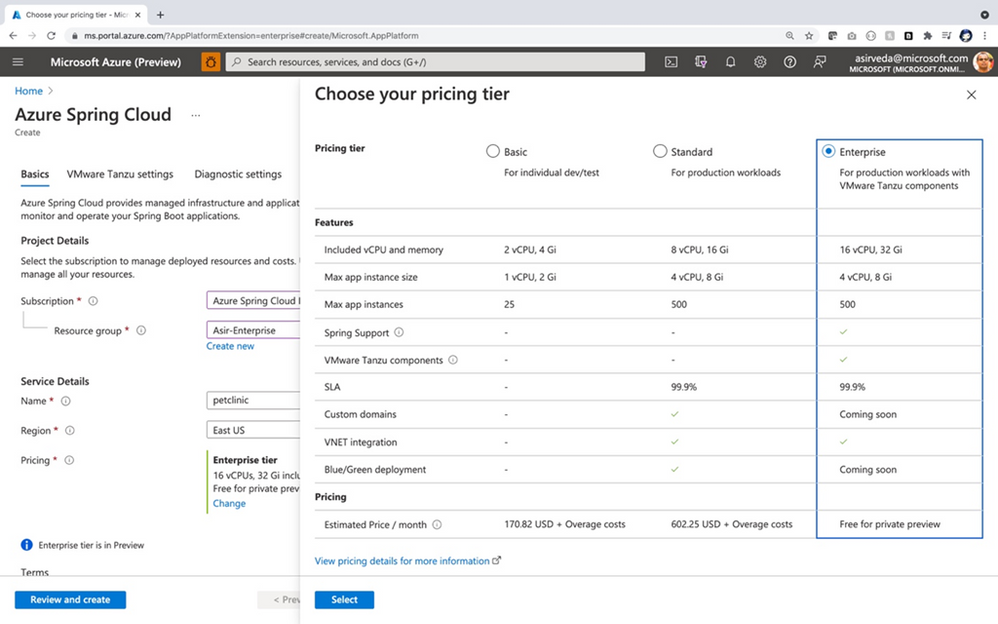
by Contributed | Sep 14, 2021 | Technology
This article is contributed. See the original author and article here.
In 2019, Microsoft and Pivotal (now VMware) announced Azure Spring Cloud, a fully managed service for Spring Boot applications. We set out to solve many of the common challenges enterprise developers face when running Spring Boot applications at scale. The service manages dynamic scaling, security patching, out-of-the-box instrumentation for monitoring, and more so developers can focus on their apps. Since then, we’ve worked with many customers including Kroger, Swiss Re, Raley’s, and Digital Realty to help them adopt the service.
We also learned that some customers need more. Many are running thousands of Spring Boot applications on-premises and need advanced capabilities to accelerate their Spring modernization projects. Based on our learnings, we started worked on a new Azure Spring Cloud tier with commercially supported components to meet the needs of enterprise customers. Now, we are announcing the availability of Azure Spring Cloud Enterprise in preview.
Azure Spring Cloud Enterprise is a managed service for Spring that is optimized for the needs of enterprise developers. We have collaborated with VMware to combine the cloud platform expertise of Microsoft with the innovation of the VMware Tanzu portfolio. Azure Spring Cloud Enterprise adds commercial Tanzu components built specifically to address enterprise requirements around configuration, integration, flexibility, and support.

Figure 1: Example—Azure Spring Cloud pricing tier selection, including Enterprise tier
Commercial VMware Tanzu components
With Azure Spring Cloud Enterprise, customers can use the VMware Tanzu components they know and love on managed Azure infrastructure. Tanzu Build Service, Tanzu Application Configuration Service, and Tanzu Service Registry are available during preview. Customers will have the flexibility to select which Tanzu components they want during or after instance creation. Microsoft and VMware will continue to add more Tanzu components such as Tanzu Spring Cloud Gateway and Spring Cloud Data Flow* to the service, providing increased value to customers.
*The Azure Spring Cloud Enterprise roadmap is not confirmed and is subject to change.
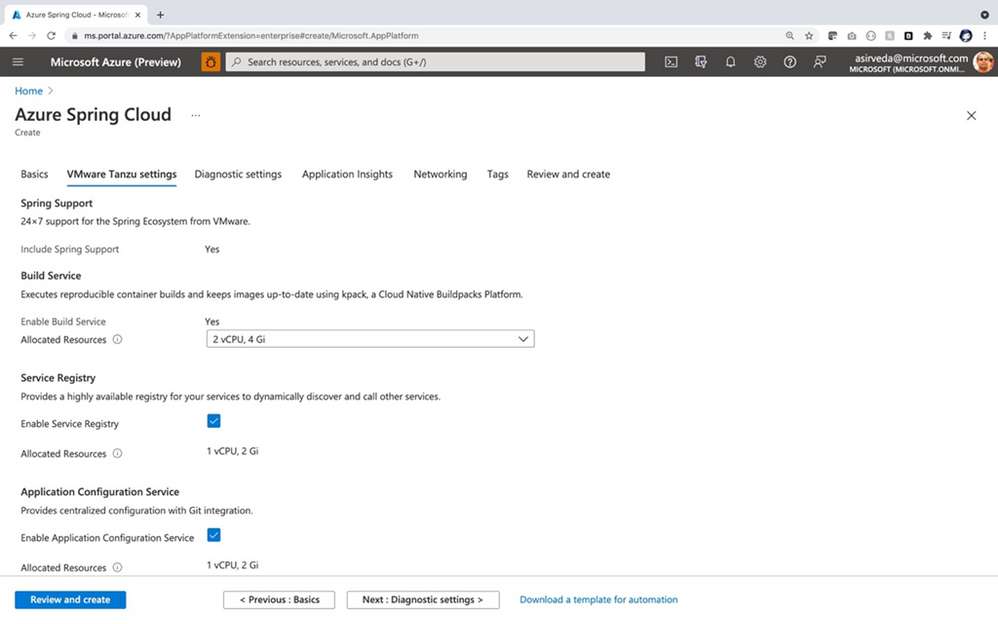
Figure 2: Example—VMware Tanzu settings and component selection in Azure portal
Advanced configurability and flexibility
Large enterprises often have complex workflows and need additional configuration options for their environments and development processes. Tanzu Build Service supports customizable Buildpack configurations that automate container creation and governance. Developers also get the full benefits of the Azure platform with limitless scaling and global deployment options, as well as integration with Azure services. And customers can move their existing Spring workloads built on Tanzu components to Azure Spring Cloud Enterprise, using the service to provide on-demand Spring Cloud infrastructure.
Spring Runtime support
Azure Spring Cloud Enterprise includes VMware Spring Runtime support for Spring projects. This gives you access to Spring experts and access to special versions of popular Spring projects specifically designed for enterprise use. With expert assistance, you can unlock the full potential of the Spring ecosystem and jumpstart your Spring application development.
Fully integrated with Azure
Azure Spring Cloud Enterprise runs on Azure in a fully managed environment. You get all the benefits of Azure, and the experience is familiar and intuitive. Just create your instances using a provisioning tool of your choice—Azure portal, Azure CLI, Azure Resource Manager Template, or Terraform.

Figure 3: Example—Azure Spring Cloud Enterprise creation review
After you create your instance and deploy your applications, you can easily monitor with Application Insights or other application performance management (APM) tools of your choice. As with the standard tier, Azure Spring Cloud Enterprise comes with out-of-the-box support for aggregating logs, metrics, distributed app traces, and alerts.
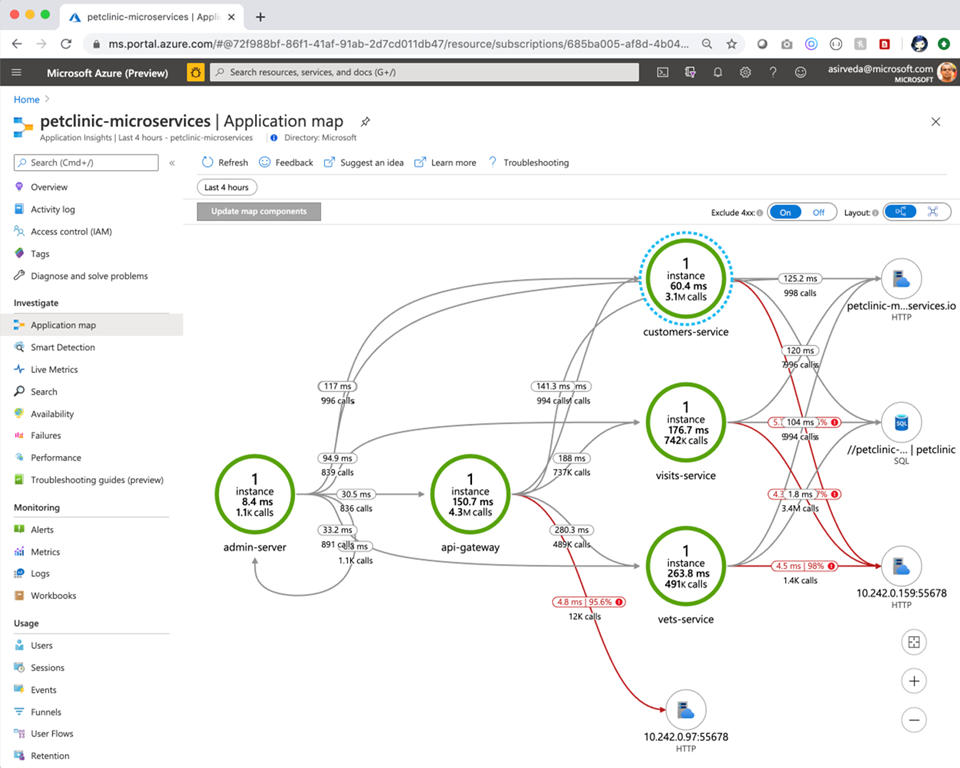
Figure 4: Example—Application transactions visible through Application Insights “Application Map”
Get started
Azure Spring Cloud Enterprise provides customers with advanced configuration capabilities and managed Tanzu components, all backed by the enterprise promises customers expect from VMware and Microsoft. We would love to see you try the service and share your feedback—sign up for the preview by clicking “Contact Me.”
You can also learn more about Azure Spring Cloud Enterprise from VMware.

by Contributed | Sep 14, 2021 | Dynamics 365, Microsoft 365, Technology
This article is contributed. See the original author and article here.
Consumers and businesses are increasingly turning to digital platforms for relevant product and service information, making it critical for companies to effectively meet and exceed customer expectations through digital services and technology. Microsoft Dynamics 365 is helping organizations meet this challenge by connecting and unifying commerce and marketing activities.
By bringing together solutions such as Dynamics 365 Commerce and Dynamics 365 Marketing, businesses can more effectively target and deliver engaging, intuitive, and user-friendly digital commerce buying experiences. These tools allow organizations to leverage machine learning models, artificial intelligence infused-personalization, and event and data-driven customer journeys, to deliver bespoke buying experiences across B2B and B2C markets.
Personalized and intuitive experiences
To effectively compete in omnichannel retail, businesses need technology solutions that allow them to deliver personalized and intuitive shopping experiences. Many customers want their shopping experience to be somehow personalized. Effective personalization can also increase store revenue. Yet, delivering personalized and intuitive experiences can be challenging for businesses that, despite multiple in-person interactions with customers and ongoing engagements with them online, cannot collect and connect the data from these experiences.
By unifying the data from every customer touchpoint, retailers can develop a more meaningful and holistic understanding of their customers. This deeper understanding can then be leveraged to quickly move customers from evaluation to purchase decision, regardless of the channel in which the customer chooses to engage. Ultimately, by delivering personalized and intuitive shopping experiences, retailers can improve overall conversion rates and maximize the lifetime value of their customers.
Ste. Michelle Wine Estates
One retailer that is seeing the benefits of delivering personalized and intuitive experiences is Ste. Michelle Wine Estates. Ste. Michelle Wine Estates, one of the largest premium wine companies in the United States, prides itself on superior consumer experiences. To unify its consumer data and provide opportunities for innovation, Ste. Michelle deployed Dynamics 365 Commerce across all of its wine brands.
“The more we know about the consumerand the more adept we can be at using that information in intelligent waysthe better we can make technology an enabler of consumer satisfaction.” Joe Gregg, Chief Information Officer, Ste. Michelle Wine Estates
Learn more: Ste. Michelle Wine Estates customer story
Seamless omnichannel services
Personalized digital customer engagement extends well beyond the confines of online marketplaces and digital storefronts. To deliver a fully seamless and frictionless buying experience, merchants must be able to effectively transition from online to brick-and-mortar and back againand do this without losing the personal touch.
Consumers are more likely to buy from retailers who reference past purchase experiences. These are easy feats for properly configured information systems in online environments, but transitioning to in-store, team member-led experiences can be tricky.
To be effective in this effort, retailers need to empower in-store team members with relevant and timely consumer data. Providing the correct data at the right time can be difficult when retailers are amassing a large amount of consumer data. Fortunately, Dynamics 365 Commerce can leverage AI and machine learning capabilities to deliver personalized recommendations, insights, and loyalty programs access directly into the hands of brick-and-mortar team members. Ultimately, by connecting digital, in-store, and back-office operations in a single retail platform, merchants can deliver the seamless purchase journeys that modern consumers and businesses have come to expect.
Signature Cosmetics & Fragrances
A retailer positioning itself to take advantage of the benefits of seamless omnichannel service is Signature Cosmetics & Fragrances. Signature Cosmetics & Fragrances, a leading cosmetics and fragrance group, understood the impact the COVID-19 pandemic and subsequent lockdowns would have on its network of more than 170 stores across South Africa, Botswana, and Namibia.
When the company began its modernization program by implementing Dynamics 365 Finance and Operations, it did not immediately consider the benefits of connecting its commercial activities in a seamless omnichannel service. As the project moved forward and they gained experience in e-commerce, they quickly grasped the value of such an approach. By implementing Dynamics 365 Commerce, Signature Cosmetics & Fragrances can now deliver a seamless experience across product categorization and loyalty programs in its brick-and-mortar stores and online. One example is that the company can now directly connect a customer’s online wish list with in-store sales opportunities.
“Part of the project plan is once we have all this data following through the productivity software in retail, e-commerce, and supply chain, we will have Power BI sitting above everything and drawing from various departments to present it as reports that really help us make decisions.” Akheel Pragjee, Managing Director of the Signature Group
Learn more: Signature Cosmetics & Fragrances customer story
Next steps
As we have seen, delivering a personalized digital customer engagement is a fundamental necessity for modern retailers. Dynamics 365 provides the ability to adapt and innovate with the only portfolio of business applications that empowers your organization to deliver operational excellence and delight every customer. Two of our solutions, Dynamics 365 Commerce and Dynamics 365 Marketing, combine to allow your company to provide a unified, or connected, commerce solution. Try our free Dynamics 365 Commerce trial today to get started creating personalized and friction-free digital commerce experiences for B2C and B2B businesses.
The post Deliver personalized digital customer engagement with Dynamics 365 appeared first on Microsoft Dynamics 365 Blog.
Brought to you by Dr. Ware, Microsoft Office 365 Silver Partner, Charleston SC.
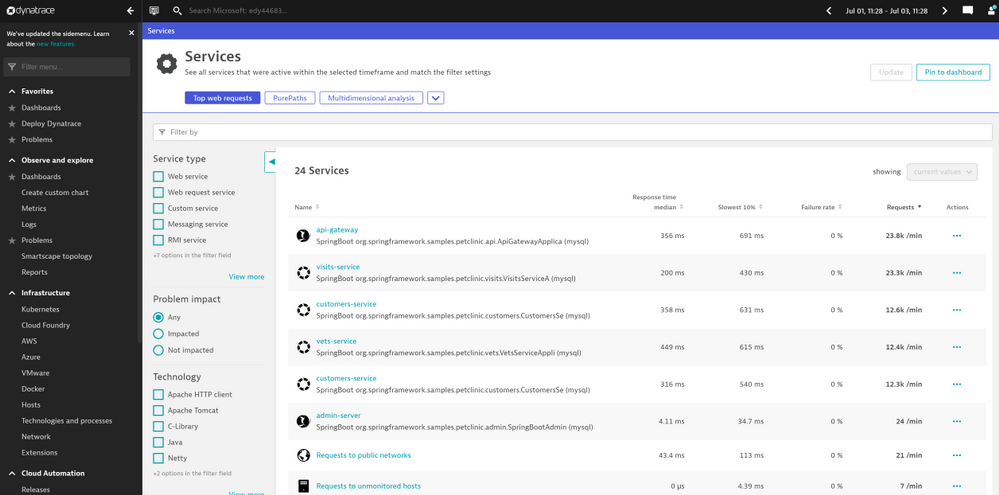
by Contributed | Sep 13, 2021 | Technology
This article is contributed. See the original author and article here.
Today, we are excited to announce the integration of the Dynatrace Software Intelligence Platform in Azure Spring Cloud.
Over the past 18 months, we worked with many enterprise customers to learn about the scenarios they face. Many of these customers have thousands of Spring Boot applications running in on-premises data centers. As they migrate these applications to the cloud, they need to instrument them for application performance monitoring (APM) using solutions their developers are familiar with and have been using for years. In addition, they must ensure continuity for desktop and mobile applications that are already pre-instrumented for end-to-end monitoring using agents like Dynatrace OneAgent, which automatically discovers and maps all applications, microservices, and infrastructure as well as any dependencies in dynamic hybrid, multi-cloud environments. With the integration of Dynatrace OneAgent in Azure Spring Cloud, you can continue your journey and easily instrument your Spring Boot applications with Dynatrace.
Continue your Dynatrace journey. Most organizations that deploy Spring Boot applications today share a similar goal: maximize the benefits of running Spring Boot applications at virtually any scale, using automation and APM. While Azure Spring Cloud excels at abstracting away much of the toil associated with managing containerized workloads, the challenge of monitoring and maintaining the performance and health of these applications, or of troubleshooting issues when they occur, can be daunting—especially as organizations deploy these applications at massive scale. To help you succeed and continue your Dynatrace journey, we integrated and upgraded your ability to instrument, monitor and deliver observability using Dynatrace OneAgent across your Azure Spring Cloud instances. That begins with setting up instrumentation quickly and easily. Then you can analyze the performance and health of your applications, JVMs, transactions, and more.
“For Liantis, true hybrid monitoring across both our on-premises and cloud-based Spring Boot microservices is key, but we also require simple and straightforward implementation – which is in line with the true Azure Spring Cloud philosophy of abstracting complexity. Doing so allows Liantis to spend more time on developing innovative applications, rather than building and operating infrastructure, which enables us to deliver true value for our customers and employees. Building on our in-house expertise with both Spring and Dynatrace technology, combined with our previous investments, the Dynatrace integration with Azure Spring Cloud was the obvious choice for Liantis.” — Nicolas Van Kerschaver, CIO, Liantis
“Being able to scale is critical for today’s digital business, as organizations have made the shift to cloud-native workloads and microservices. While cloud-native technologies and microservices have tremendous advantages, dynamic environments bring complexity that makes it difficult to understand the relationships and dependencies across an organization’s cloud ecosystem. Dynatrace’s strategic partnership with Microsoft allows us to extend the impact of our automatic and intelligent observability even further to accelerate digital transformation. Through the Dynatrace integration with Azure Spring Cloud, we are enabling full visibility into application data for Spring Boot applications, which means more time innovating and a better product for end-users.” – Eric Horsman, Global Director of Strategic Alliances, Dynatrace
“At Microsoft, we are committed to helping our customers modernize their applications and innovate faster than ever before. By integrating a software intelligence solution like Dynatrace with Azure Spring Cloud, we can enable our customers with easy implementation of end-to-end observability, including automatic and continuous root-cause analysis, for their Spring Boot applications.” — Julia Liuson, Corporate Vice President, Developer Division, Microsoft
Instrument your Spring Boot applications. Run a “provisioning” automation pipeline for a complete hands-off experience to instrument and monitor any new applications that you create and deploy – using Terraform or ARM Template. Or you can run it on-demand using the Azure CLI for greater flexibility and control.
az spring-cloud app update --name customers-service
--env DT_TENANT=<your-tenant> DT_TENANTTOKEN=<your-tenant-token>
DT_CONNECTION_POINT=<your-connection-point>
Automatic discovery and mapping of applications and their dependencies. To maintain real-time awareness in dynamic environments, Dynatrace automatically discovers and maps application components (including application servers, frameworks and microservices), databases, messaging and eventing systems, and their relationships. In the view shown below, the Dynatrace Portal shows all the Spring Boot applications running in a production workload.

Screenshot 1 – shows all the Spring Boot applications running in a production workload
End-to-end observability of Spring Boot applications’ complete HTTP/S transactional behavior to understand the effect on business outcomes and user experiences. In the example view below, Dynatrace provides developers with all the transaction traces implemented in code without any code change to applications.
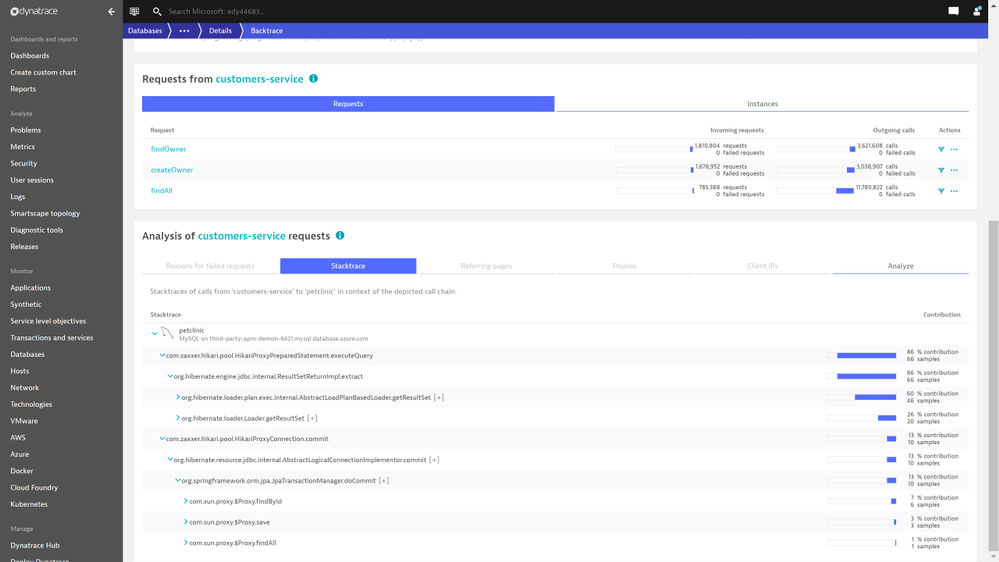
Screenshot 2 – shows transaction traces implemented in code without any code change to applications
Endpoint monitoring, API monitoring, DB calls monitoring, end-user experience monitoring. Dynatrace captures all the database queries initiated by your Spring Boot applications, including Azure database services. In the example view below, Dynatrace Portal shows all the active REST API operations within a production workload.
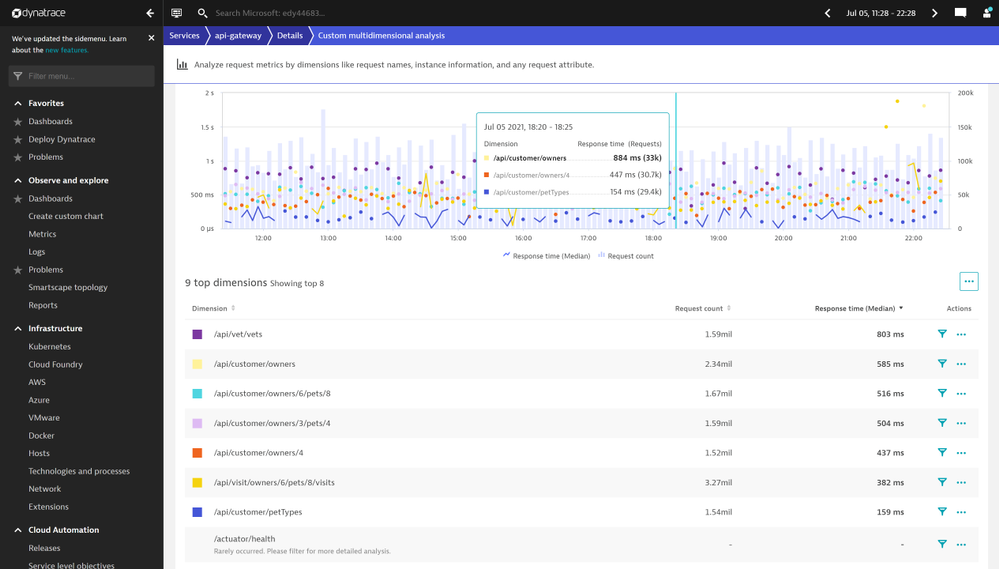
Screenshot 3 – shows all the active REST API operations within a production workload
In the example view below, the Dynatrace Portal shows all the database queries initiated by a production workload.
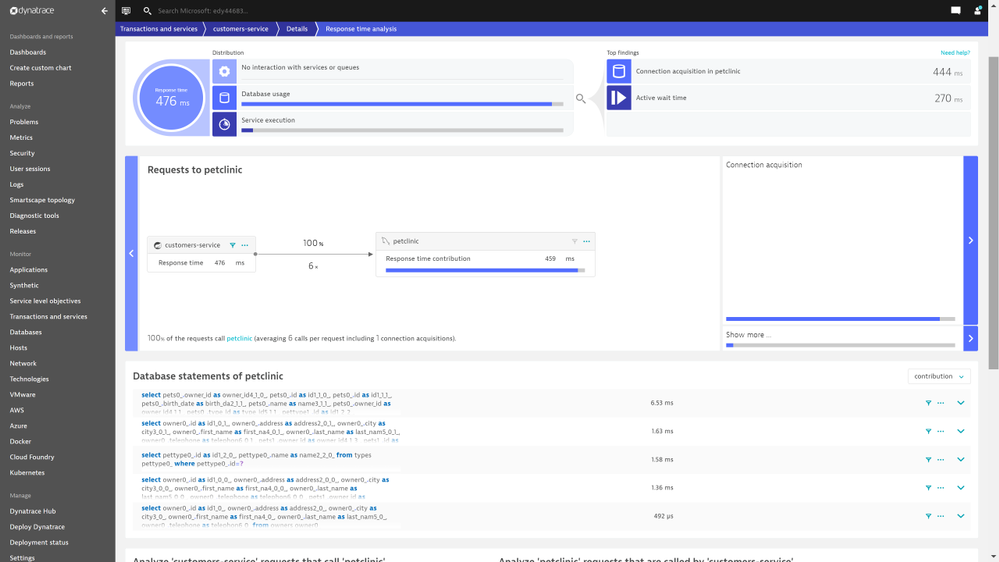
Screenshot 4 – shows all the database queries initiated by a production workload
Root-cause and impact analysis of application performance problems and business outcomes for faster, more reliable incident resolution. Dynatrace provides deep-code level visibility with end-to-end traces and the integration provides AI-assisted problem detection and automatic root-cause analysis allowing you to stay on top of your deployments and distinguish between healthy and unhealthy applications.
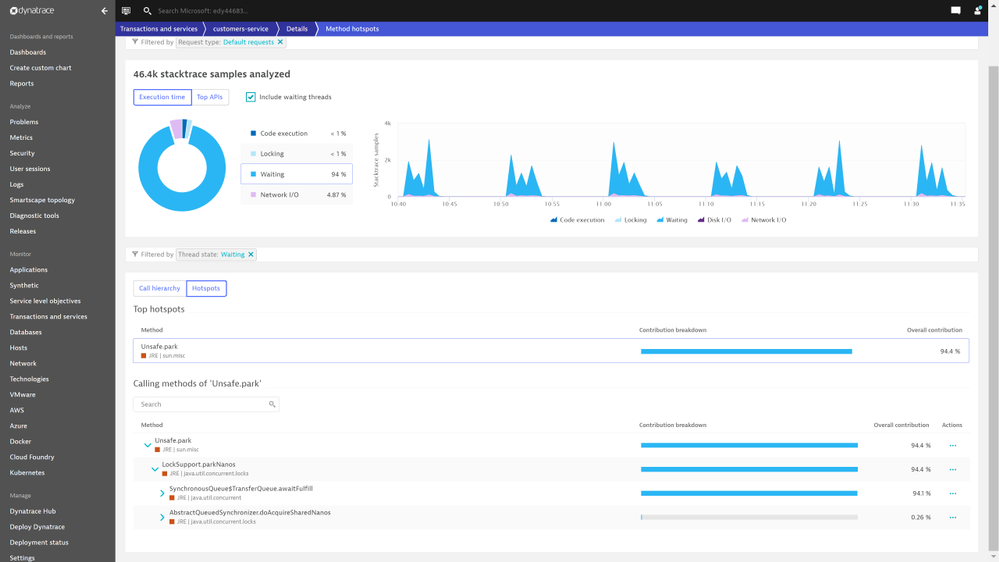
Screenshot 5 – shows results from stack trace analysis
Detect anomalies in your Spring Boot application instances. Dynatrace passes the collected data through an AI engine for automated root cause analysis, code level hotspot analysis, top database queries, and exception analysis. In the example screenshot below, Dynatrace automatically identifies code modules that are CPU intensive so that you do not have to dig through the data.
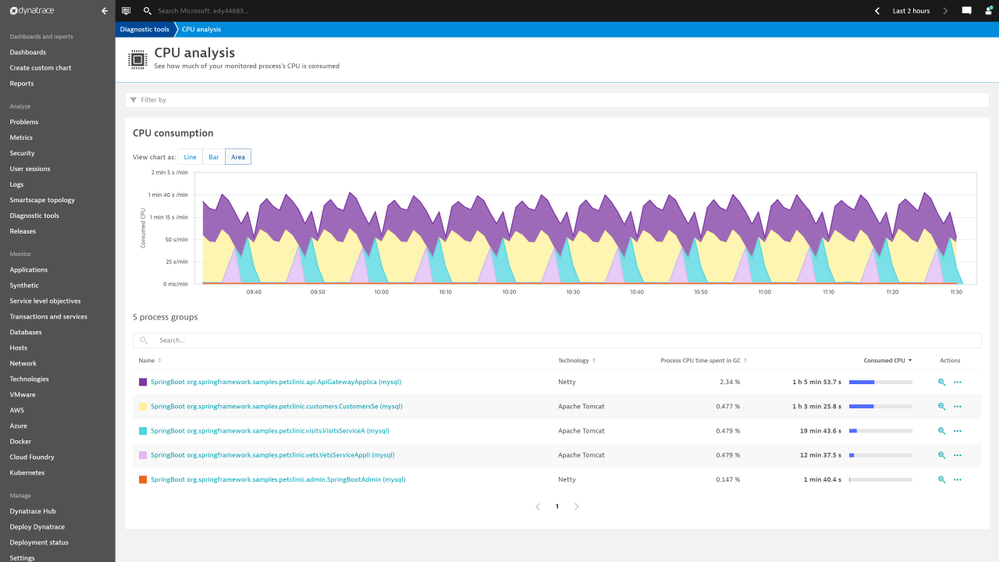
Screenshot 6 – code modules that are CPU intensive so that you do not have to dig through the data
You can find all the top database queries initiated, how expensive these queries are, and how many times these queries are called by applications. In the example screenshot below, Dynatrace shows top database queries initiated by a production workload.
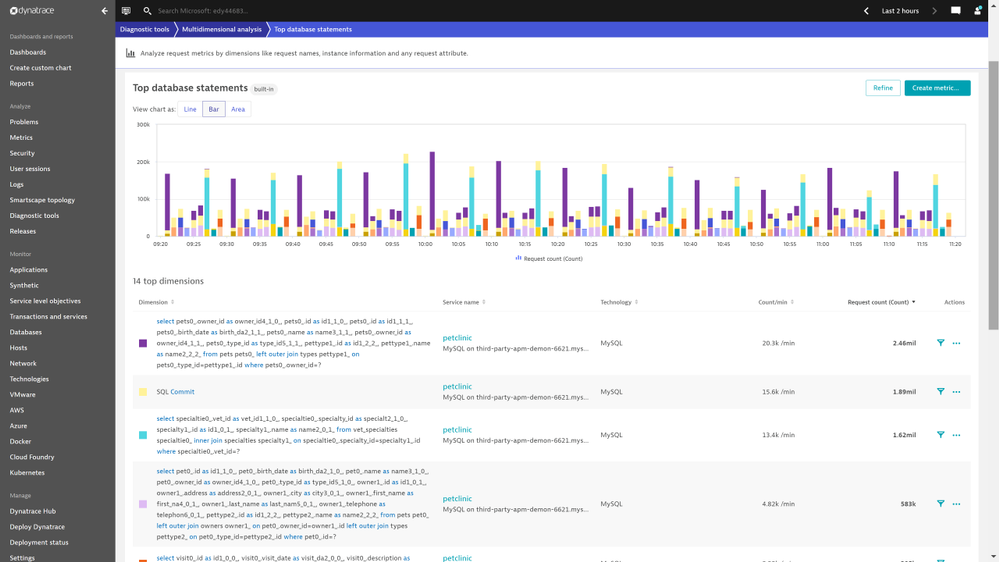
Screenshot 7 – shows top database queries initiated by a production workload
All application code level exceptions are logged along with many details into the stack traces of where the exception occurred. In the example screenshot below, Dynatrace portal shows the top exceptions thrown by a production workload.
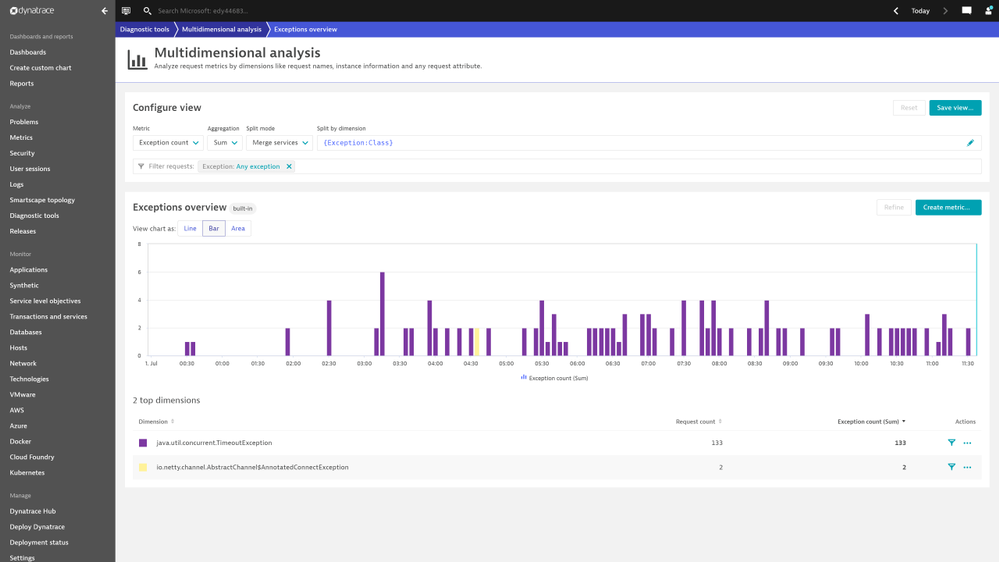
Screenshot 8 – shows the top exceptions thrown by a production workload
The Dynatrace Software Intelligence Platform automatically baselines all the performance metrics of Spring Boot applications. When the response times of an application increase beyond the auto detected baseline, the platform creates an alert with information like how much response times have breached from baselines. In the example screenshot below, Dynatrace shows response time degradation for a few services in a production workload.
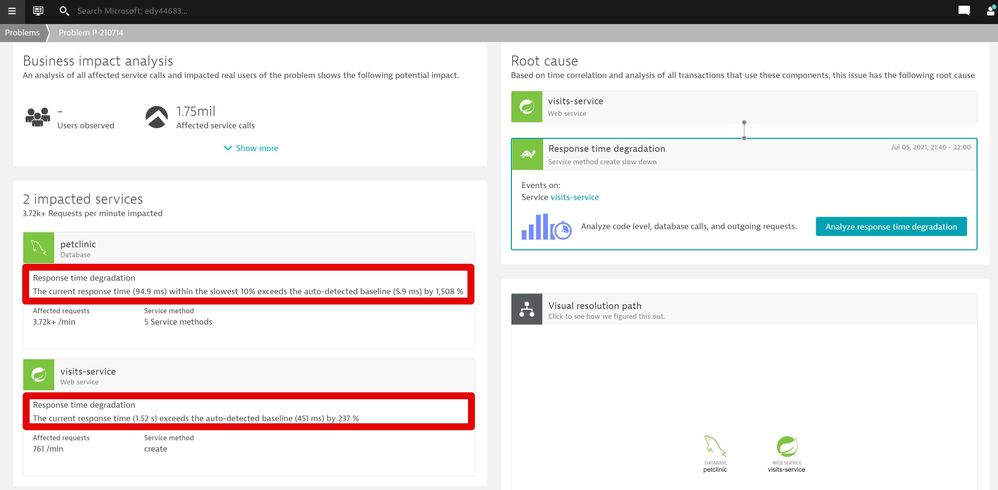
Screenshot 9 – shows response time degradation for a few services in a production workload
Dynatrace gives you insights on what caused these increases in response time, particularly the time taken to make a connection to a database service. In the example below, the Dynatrace portal calls out the time taken to make connections to a database.
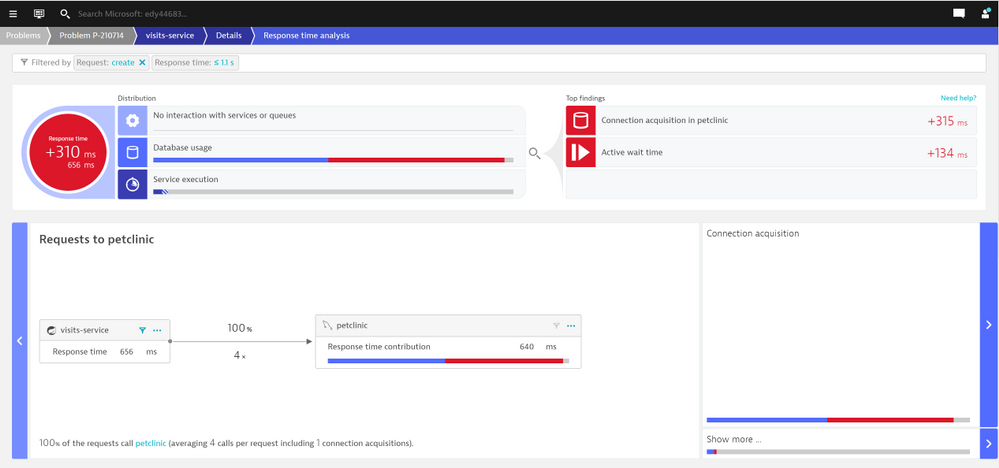
Screenshot 10 – shows time taken to make connections to a database
Dynatrace automatically detects all the failures. In the example below, Dynatrace signals an increase in failure rates to reach an external network.
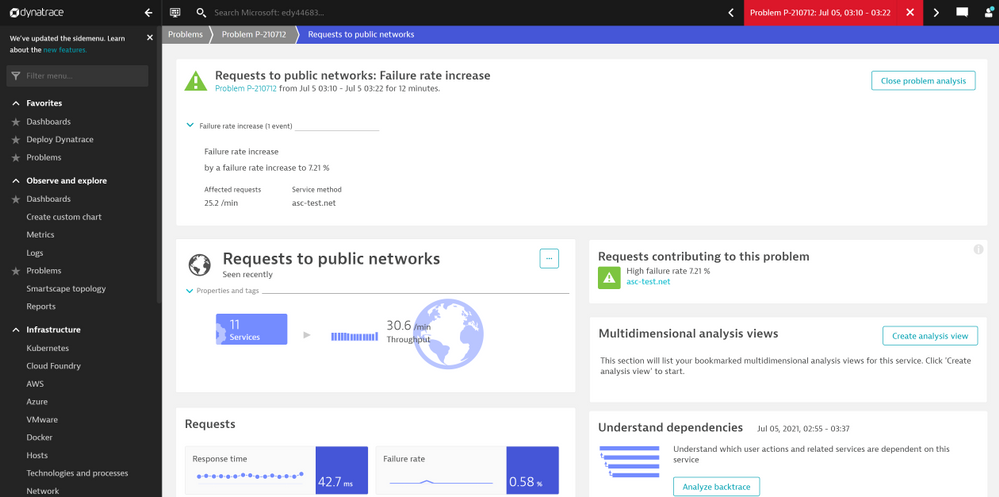
Screenshot 11 – signals an increase in failure rates to reach an external network
Focus on delivering value to your end-users. Once instrumented, as you scale out to multiple Spring Boot application instances, any new application instances are automatically monitored for you. Dynatrace enables application developers to observe Spring Boot applications end-to-end. You spend less time managing the agent installation and maintenance and more energy on identifying and resolving incidents faster. Azure Spring Cloud service is on-point for periodically updating the Dynatrace OneAgent.
Build your solutions and monitor them today!
Azure Spring Cloud is jointly built, operated, and supported by Microsoft and VMware. It is a fully managed service for Spring Boot applications that abstracts away the complexity of infrastructure and Spring Cloud middleware management, so you can focus on building your business logic and let Azure take care of dynamic scaling, patches, security, compliance, and high availability. With a few steps, you can provision Azure Spring Cloud, create applications, deploy, and scale Spring Boot applications and start monitoring in minutes. We will continue to bring more developer-friendly and enterprise-ready features to Azure Spring Cloud.
We would love to hear how you are building impactful solutions using Azure Spring Cloud. Start monitoring your Spring Boot applications with Dynatrace.
Resources
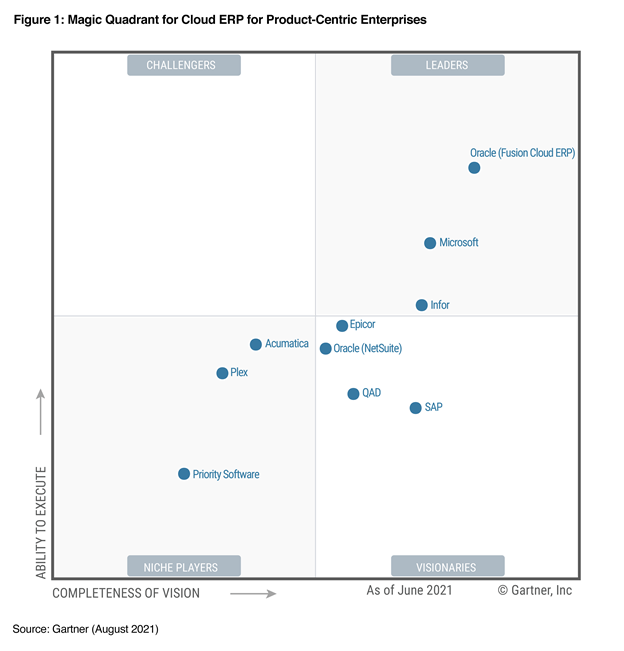
by Contributed | Sep 13, 2021 | Dynamics 365, Microsoft 365, Technology
This article is contributed. See the original author and article here.
We are thrilled that Gartner has recognized Microsoft as a Leader in the 2021 Magic Quadrant for Cloud ERP for Product-Centric Enterprises for Microsoft Dynamics 365.

Dynamics 365 Supply Chain Management and Dynamics 365 Finance offer businesses two standardized enterprise resource planning (ERP) capabilities on a composable ERP platform, functioning as stand-alone solutions or as a tightly integrated and extensible system. As product-centric enterprises look to renovate their existing ERP platform to improve systems and processes by moving them to the cloud, Dynamics 365 is enabling the transformation and improving IT agility to deliver business outcomes in the process.
For example, Bel Fuse recently selected Dynamics 365 Finance and Dynamics 365 Supply Chain Management to move away from a legacy version of Oracle that was highly customized and difficult to update. Bel Fuse was able to unify its data and can now more easily manage its supply chain operations and finance processes, gaining more agility to respond quickly to changes in the market.
Dynamics 365 also delivers an enterprise SaaS application capable of providing data, analytical insight, and operational application services by running on the Microsoft Azure cloud. The Azure cloud enables clients to use Microsoft Power Platform for analytics and Microsoft Power Apps for low-code/no-code extensions, allowing organizations to improve operations with real-time, AI-based predictive insights across a broader ERP strategy.
An excellent example of a company leveraging these capabilities is GN Group. GN Group recently adopted Dynamics 365 Supply Chain Management and Dynamics 365 Finance to centralize all its ERP data in the cloud. With help from Microsoft Partner Network member SCALES Group, GN Group evolved its supply chain processes to be more agile and structured. It uses Dynamics 365 Finance to unify financial data and gain AI-based predictive insights in real-time. The company also adopted Microsoft Power Platform to extend its Dynamics 365 business applications. So far, GN Group uses Microsoft Power BI for reporting and analytics and Microsoft Power Apps to build a custom, vendor-managed inventory (VMI) solution that seamlessly connects to Dynamics 365 Supply Chain Management.
And we continue to invest and expand our capabilities. At the end of July, we acquired Suplari, a leading provider of supplier spend insights that enable companies to proactively manage supplier spend by transforming data from multiple sources, such as contracts, purchase orders, invoices, expenses, and supplier risk, into valuable insight. By bringing Suplari’s spend intelligence insights together with the existing Dynamics 365 capabilities, Microsoft is further helping organizations become insight-driven and enabling business leaders to take strategic action. In August, Dynamics 365 Intelligent Order Management became generally available. It enables enterprises to optimize and automate fulfillment using real-time inventory, AI, and machine learning. Organizations can truly gain the agility they need to quickly adapt to changing business models, support the latest fulfillment methods, add new order intake channels by seamlessly integrating their existing ERP systems to manage the entire order lifecycle from intake to fulfillment.
Request a demo or take a guided tour of Dynamics 365 Supply Chain Management and Dynamics 365 Finance.
* This graphic was published by Gartner, Inc. as part of a larger research document and should be evaluated in the context of the entire document. The Gartner document is available upon request from Microsoft.
GARTNER and Magic Quadrant are registered trademarks and service mark of Gartner, Inc. and/or its affiliates in the U.S. and internationally and are used herein with permission. All rights reserved. Gartner does not endorse any vendor, product or service depicted in its research publications, and does not advise technology users to select only those vendors with the highest ratings or other designation. Gartner research publications consist of the opinions of Gartner’s research organization and should not be construed as statements of fact. Gartner disclaims all warranties, expressed or implied, with respect to this research, including any warranties of merchantability or fitness for a particular purpose.
Gartner, Magic Quadrant for Cloud ERP for Product-Centric Enterprises, 24 August 2021, Tim Faith, Denis Torii, Paul Schenck, Dixie John, Abhishek Singh.
The post Gartner® Recognizes Microsoft as a Leader in the 2021 Gartner Magic Quadrant™ for Cloud ERP for Product-Centric Enterprises appeared first on Microsoft Dynamics 365 Blog.
Brought to you by Dr. Ware, Microsoft Office 365 Silver Partner, Charleston SC.
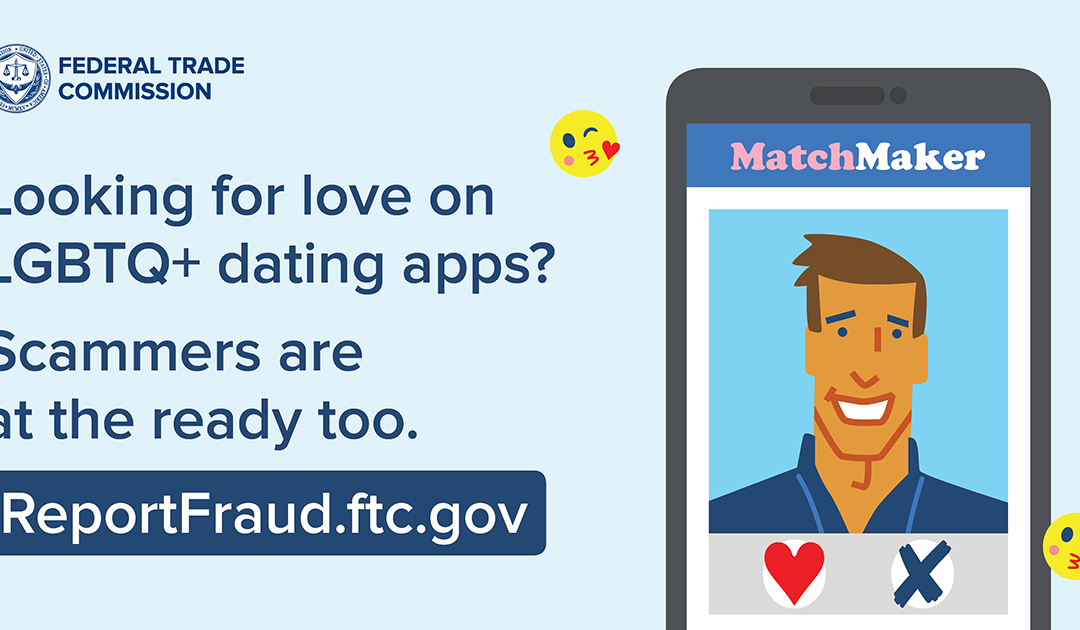
by Scott Muniz | Sep 13, 2021 | Security
This article was originally posted by the FTC. See the original article here.
Looking for love on LGBTQ+ dating apps? Scammers are at the ready too.
We’re hearing about scams targeting people on LGBTQ+ dating apps, like Grindr and Feeld. And they aren’t your typical I-love-you, please-send-money romance scams. They’re extortion scams.
They usually work something like this: a scammer poses as a potential romantic partner on an LGBTQ+ dating app, chats with you, quickly sends explicit photos, and asks for similar photos in return. If you send photos, the blackmail begins. They threaten to share your conversation and photos with your friends, family, or employer unless you pay — usually by gift card. To make their threats more credible, these scammers will tell you the names of exactly who they plan to contact if you don’t pay up. This is information scammers can find online by using your phone number or your social media profile.
Other scammers threaten people who are “closeted” or not yet fully “out” as LGBTQ+. They may pressure you to pay up or be outed, claiming they’ll “ruin your life” by exposing explicit photos or conversations.
Whatever their angle, they’re after one thing — your money.
If you’re looking for love on dating apps, here are some ways to avoid these scams:
- Check out who you’re talking to. Do a reverse image search of the person’ profile picture to see if it’s associated with another name or with details that don’t match up – those are signs of a scam.
- Don’t share personal information with someone you just met on a dating app. That includes your cell phone number, email address, and social media profile.
- Don’t pay scammers to destroy photos or conversations. There’s no guarantee they’ll do it.
In fact, the FBI advises against paying extortion demands, which could support criminal activity.
And remember that, once you share photos, you can’t take them back.
If you think someone is trying to extort you:
Are you under 25 and looking to connect with a counselor at an LGBTQ+ organization about what happened? Reach out to The Trevor Project. They have free counselors, available 24/7, who can talk to you through their phone, chat and text services.
Brought to you by Dr. Ware, Microsoft Office 365 Silver Partner, Charleston SC.






















Recent Comments